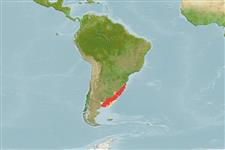Common names from other countries
Classification / Names / Names
ชื่อสามัญ | ชื่อพ้อง | Catalog of Fishes (gen., sp.) | ITIS | CoL | WoRMS
Environment: milieu / climate zone / depth range / distribution range
นิเวศวิทยา
; ระดับความลึก 0 - 90 m (Ref. 275). Subtropical; 30°S - 44°S, 65°W - 50°W (Ref. 107078)
Southwest Atlantic: from Brazil to Argentina.
Length at first maturity / ขนาด / น้ำหนัก / Age
Maturity: Lm ? range ? - ? cm Max length : 30.0 cm TL เพศผู้/กระเทย; (Ref. 105659)
Minimum depth assumed from its ecology. Inhabits intertidal and shallow subtidal zones, on reefs and sandy areas. Found on crevices, boulders and empty gastropod and bivalve shells. Selectively feeds on grapsid crabs and small bivalves. Known to extract living hermit crabs on gastropod shells via drilling. Major source of food for juvenile shark in Argentinean waters (Ref. 96968).
Life cycle and mating behavior
วัยเจริญพันธุ์ | การสืบพันธุ์ | การวางไข่ | เซลสืบพันธ์ของเพศเมีย(ไข่) | ความดกของไข่ | ตัวอ่อน
Members of the class Cephalopoda are gonochoric. Male and female adults usually die shortly after spawning and brooding, respectively. Mating behavior: Males perform various displays to attract potential females for copulation. During copulation, male grasp the female and inserts the hectocotylus into the female's mantle cavity where fertilization usually occurs. Life cycle: Embryos hatch into planktonic stage and live for some time before they grow larger and take up a benthic existence as adults.
Roper, C.F.E., M.J. Sweeney and C.E. Nauen. 1984. (Ref. 275)
IUCN Red List Status (Ref. 130435)
CITES status (Ref. 108899)
Not Evaluated
Not Evaluated
Human uses
การประมง: การค้า
| FishSource |
เครื่องมือ
ข้อมูลเพิ่มเติม
Age/SizeการเจริญเติบโตLength-weightLength-lengthสัณฐานวิทยาตัวอ่อนอุดมสมบรูณ์
แหล่งที่มาจากอินเตอร์เน็ต
Estimates based on models
Preferred temperature
(Ref.
115969): 10.8 - 17.6, mean 14.7 (based on 106 cells).
Vulnerability
Low vulnerability (10 of 100).
